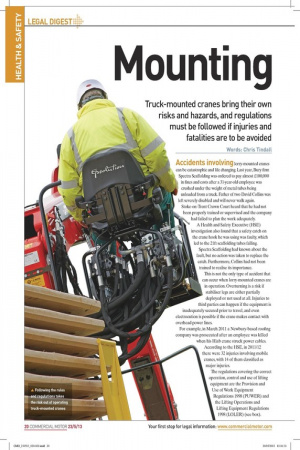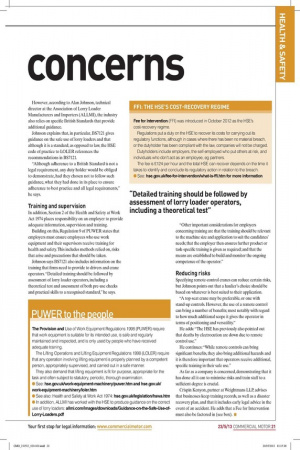Mounting concerns Truck-mounted cranes bring their own risks and hazards,
Page 15

Page 16

If you've noticed an error in this article please click here to report it so we can fix it.
and regulations must be followed if injuries and fatalities are to be avoided Words: Chris Tindall Accidents involving lorry-mounted cranes can be catastrophic and life changing. Last year, Bury firm Spectra Scaffolding was ordered to pay almost £100,000 in fines and costs after a 31-year-old employee was crushed under the weight of metal tubes being unloaded from a truck. Father of two David Collins was left severely disabled and will never walk again. Stoke-on-Trent Crown Court heard that he had not been properly trained or supervised and the company had failed to plan the work adequately.
A Health and Safety Executive (HSE) investigation also found that a safety catch on the crane hook he was using was faulty, which led to the 21ft scaffolding tubes falling. Spectra Scaffolding had known about the fault, but no action was taken to replace the catch. Furthermore, Collins had not been trained to realise its importance.
This is not the only type of accident that can occur when lorry-mounted cranes are in operation. Overturning is a risk if stabiliser legs are either partially deployed or not used at all. Injuries to third parties can happen if the equipment is inadequately secured prior to travel, and even electrocution is possible if the crane makes contact with overhead power lines.
For example, in March 2011 a Newbury-based roofing company was prosecuted after an employee was killed when his Hiab crane struck power cables. According to the HSE, in 2011/12 there were 32 injuries involving mobile cranes, with 14 of them classified as major injuries.
The regulations covering the correct operation, control and use of lifting equipment are the Provision and Use of Work Equipment Regulations 1998 (PUWER) and the Lifting Operations and Lifting Equipment Regulations 1998 (LOLER) (see box). However, according to Alan Johnson, technical director at the Association of Lorry Loader Manufacturers and Importers (ALLMI), the industry also relies on specific British Standards that provide additional guidance.
Johnson explains that, in particular, B57121 gives guidance on the safe use of lorry loaders and that although it is a standard, as opposed to law, the HSE code of practice to LOLER references the recommendations in B57121.
"Although adherence to a British Standard is not a legal requirement, any duty holder would be obliged to demonstrate, had they chosen not to follow such guidance, what they had done in its place to ensure adherence to best practice and all legal requirements," he says.
Training and supervision In addition, Section 2 of the Health and Safety at Work Act 1974 places responsibility on an employer to provide adequate information, supervision and training.
Building on this, Regulation 9 of PUVVER states that employers must ensure employees who use work equipment and their supervisors receive training for health and safety. This includes methods relied on, risks that arise and precautions that should be taken.
Johnson says B57121 also includes information on the training that firms need to provide to drivers and crane operators. "Detailed training should be followed by assessment of lorry loader operators, including a theoretical test and assessment of both pre-use checks and practical skills to a recognised standard," he says. "Other important considerations for employers concerning training are that the training should be relevant to the machine size and application to suit the candidates' needs; that the employer then ensures further product or task-specific training is given as required; and that the means are established to build and monitor the ongoing competence of the operator."
Reducing risks Specifying remote-control cranes can reduce certain risks, but Johnson points out that a haulier's choice should be based on whatever is best suited to their application.
"A top-seat crane may be preferable, or one with stand-up controls. However, the use of a remote control can bring a number of benefits; most notably with regard to how much additional scope it gives the operator in terms of positioning and versatility."
He adds: "The HSE has previously also pointed out that deaths by electrocution are down due to remote control use."
He continues: "While remote controls can bring significant benefits, they also bring additional hazards and it is therefore important that operators receive additional, specific training in their safe use."
As far as a company is concerned, demonstrating that it has done all it can to minimise risks and train staff to a sufficient degree is crucial.
Crispin Kenyon, partner at Weightmans LLP, advises that businesses keep training records, as well as a disaster recovery plan, and that it includes early legal advice in the event of an accident. He adds that a Fee for Intervention must also be factored in (see box). • FFI: THE HSE'S COST-RECOVERY REGIME Fee for Intervention (FFI) was introduced in October 2012 as the HSE's cost-recovery regime.
Regulations put a duty on the HSE to recover its costs for carrying out its regulatory functions, although in cases where there has been no material breach, or the dutyholder has been compliant with the law, companies will not be charged.
Dutyholders include employers, the self-employed who put others at risk, and individuals who don't act as an employee, eg partners.
The fee is £124 per hour and the total HSE can recover depends on the time it takes to identify and conclude its regulatory action in relation to the breach.
• See: hse.gov.uktfee-for-intervention/what-is-ffi.htm for more information The Provision and Use of Work Equipment Regulations 1998 (PUWER) require that work equipment is suitable for its intended use, is safe and regularly maintained and inspected, and is only used by people who have received adequate training.
The Lifting Operations and Lifting Equipment Regulations 1998 (LOLER) require that any operation involving lifting equipment is properly planned by a competent person, appropriately supervised, and carried out in a safe manner.
They also demand that lifting equipment is fit for purpose, appropriate for the task and often subject to statutory, periodic, thorough examination.
• See: hse.gov.uk/work-equipment-machinery/puwer.htm and hse.gov.uW work-equipment-machinery/loler.htm • See also: Health and Safety at Work Act 1974: hse.gov.uk/legislation/hswa.htm • In addition, ALLMI has worked with the HSE to produce guidance on the correct use of lorry loaders: allmi.com/images/downloads/Guidance-on-the-Safe-Use-ofLorry-Loaders.pdf









































